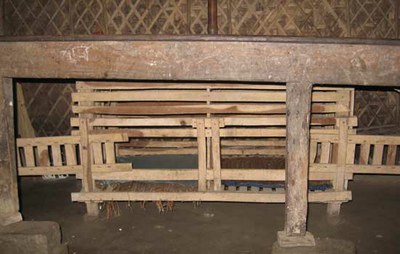Wooden poultry sheds - a source of income for poor carpenters
Dec 12, 2007
Ainul Bepari, a professional carpenter lives in Kishoregonj Sadar area. He has a son and two daughters. He had neither his own shop nor any land to cultivate. Unable to afford land, the family built a cottage on someone else’s property. Ainul worked in a furniture shop on a daily wage basis. His wife, Amena had to work as a domestic help to support the family. Sometimes Ainul had no work in hand. With modernization, opportunities for work were decreasing day by day. Moreover, the demand for wooden furniture was on the decline with people moving towards iron or steel furniture. With these changing trends, Ainul was soon unemployed. This severely affected him and his family, and he found it increasingly difficult to provide for two square meals for his family.

In the mean time, BRAC developed a prototype of wooden shelters for rearing poultry birds. Ainul saw this as an opportunity to rid himself of his poverty as well as to become self-employed and started making these wooden shelters. The raw material was easily available and cheap. He could manufacture on an average 7 shelters in a day and could sell each shelter at 300 Tk. making a reasonable profit of about 250-300 Tk./day. Many rural households were interested to rear their poultry birds in such shelters. As a result, the demand was increasing day by day. Moreover, the shelters could be used for several months before requiring a replacement. Therefore, there was a requirement of shelters on a regular basis.
Ainul has experienced a significant improvement in his economic condition after involving himself in making these wooden shelters. Now he is neither a seasonal carpenter nor a daily wage worker in someone else’s furniture shop. He builds poultry shelters in his house and supplies them to rural households. He is planning to set up a shop in the nearby market for the manufacture and supply of wooden shelters in other areas as the demand for these shelters is rising. He feels that he now earns enough to maintain his family. He is also able to save some money for the future. His wife is now not working as a domestic help. Instead, she involves herself in the CFPR-TUP (Challenging the Frontiers of Poverty Reduction-Targeting the Ultra Poor) programme initiated by BRAC. She took a 3-day training course on the rearing of livestock after which she received an asset grant of ‘1 cow plus 10 poultry birds’ from BRAC. She also uses the specially designed wooden shelter for the rearing of poultry birds.
Both Ainul and Amena are now self employed and earn a living for their family. It has helped to improve their lives and elevate their social status. They now have enough to eat and their children have resumed their education. BRAC’s innovation of wooden shelters has helped in creating employment opportunities and improving the lives of the rural poor.e took a 3-day training course on the rearing of livestock after which she received an asset grant of ‘1 cow plus 10 poultry birds’ from BRAC. She also uses the specially designed wooden shelter for the rearing of poultry birds.
Contributed by – BRAC Bangladesh (2008)



